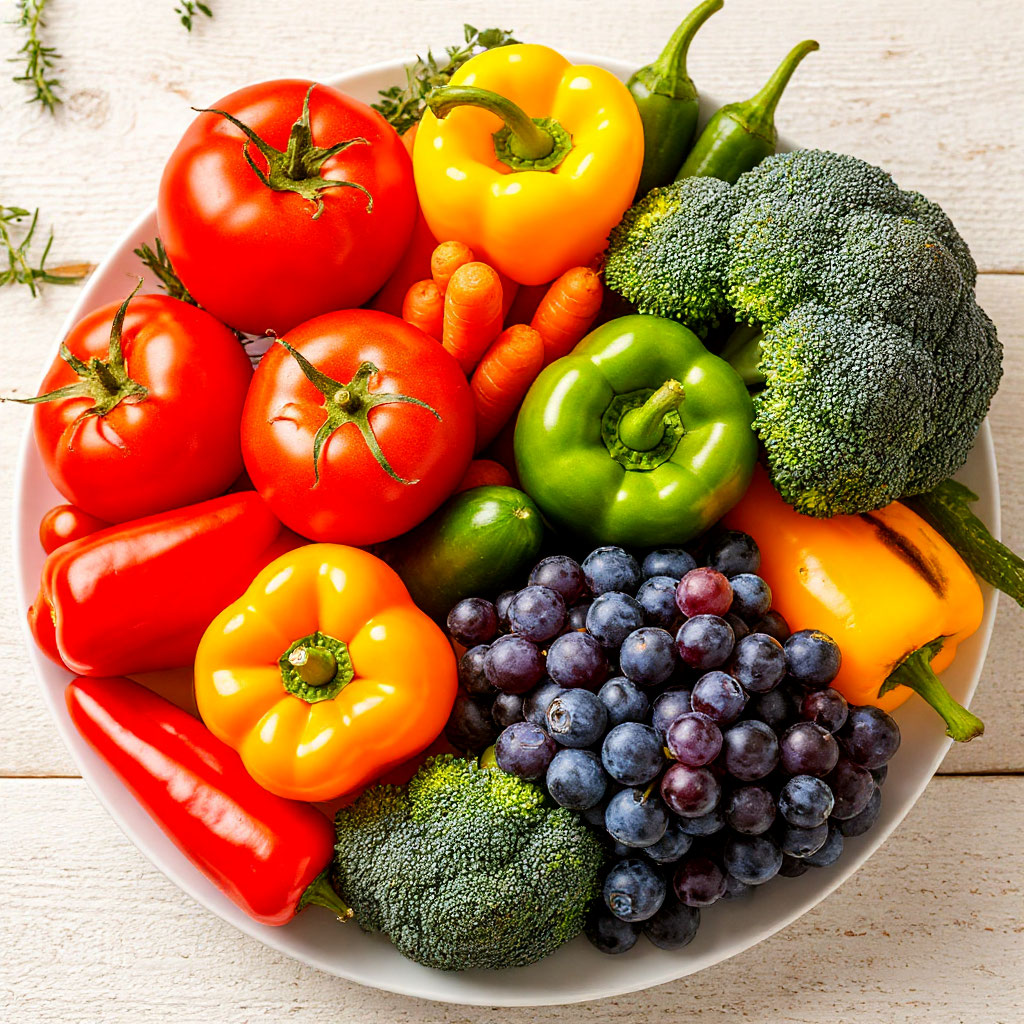
Imagine that your plate is an artist’s palette, and the products are bright colors that not only please the eye, but also give health.
The color diet is a simple and delicious way to eat a balanced diet, using the natural properties of vegetables, fruits and other products. Each shade is a signal: red energizes, green cleanses and purple protects the cells. There are no strict prohibitions, only harmony of color and benefits. Do you want to easily choose a menu, improve your digestion and even raise your mood? Then this system is for you!
What is the color diet?
Colorful products are not just beautiful but also useful. The color diet is a nutrition system that focuses on natural shades of vegetables, fruits, herbs, and other natural ingredients. Each color is associated with certain phytonutrients — biologically active substances that promote health and prevent various diseases.
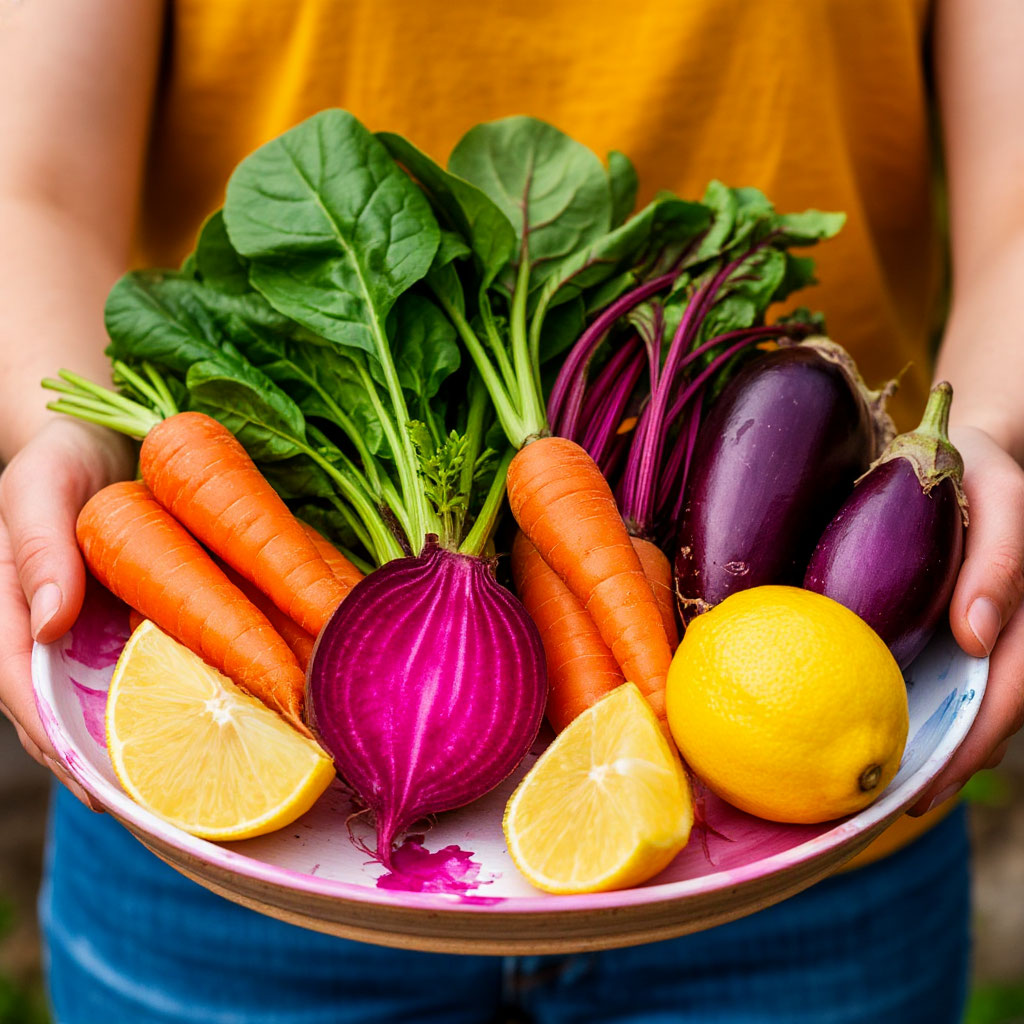
How did the idea come about?
The concept of color-based nutrition originates in research on antioxidants and their effects on the body. Scientists have noticed that plant pigments not only give fruits rich tones, but also have unique properties. For example, lycopene in red tomatoes supports the cardiovascular system, and anthocyanins in blue berries slow down the aging process.
Rainbow on a plate — the basis of the system
The essence of the color diet is the daily inclusion of products of different shades in the diet. This ensures a variety of nutrients and helps avoid vitamin deficiencies. The method does not require strict restrictions: you can combine ingredients, experiment with recipes and enjoy the taste.
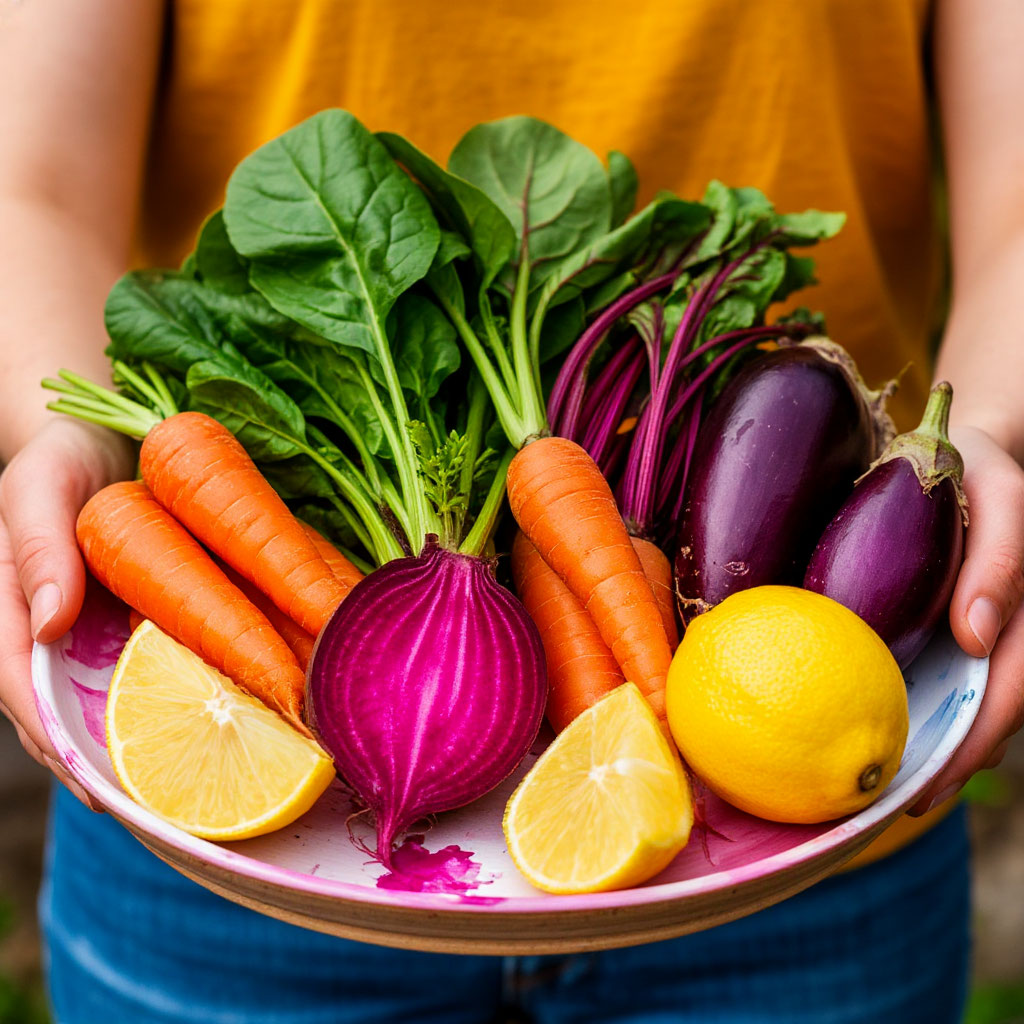
Why does this work?
Color therapy in nutrition is not a myth, but a scientifically based approach. Different colors correspond to different nutrients:
- Red (tomatoes, strawberries) – contain lycopene and anthocyanins, strengthen the heart.
- Orange and yellow fruits (carrots, oranges) are rich in beta-carotene and are good for vision.
- Greens (spinach, broccoli) – a source of chlorophyll, purify the body.
- Blue and purple fruits (blueberries, eggplants) — contain antioxidants and protect cells.
- White (cauliflower, garlic) – have anti-inflammatory properties.
Who can use this format?
The color diet is universal and suitable for almost everyone. It is especially useful:
- those who want to diversify their diet without strict restrictions;
- people who care about the health and youth of the body;
- those who strive for mindful eating;
- lovers of beautiful and aesthetic food.
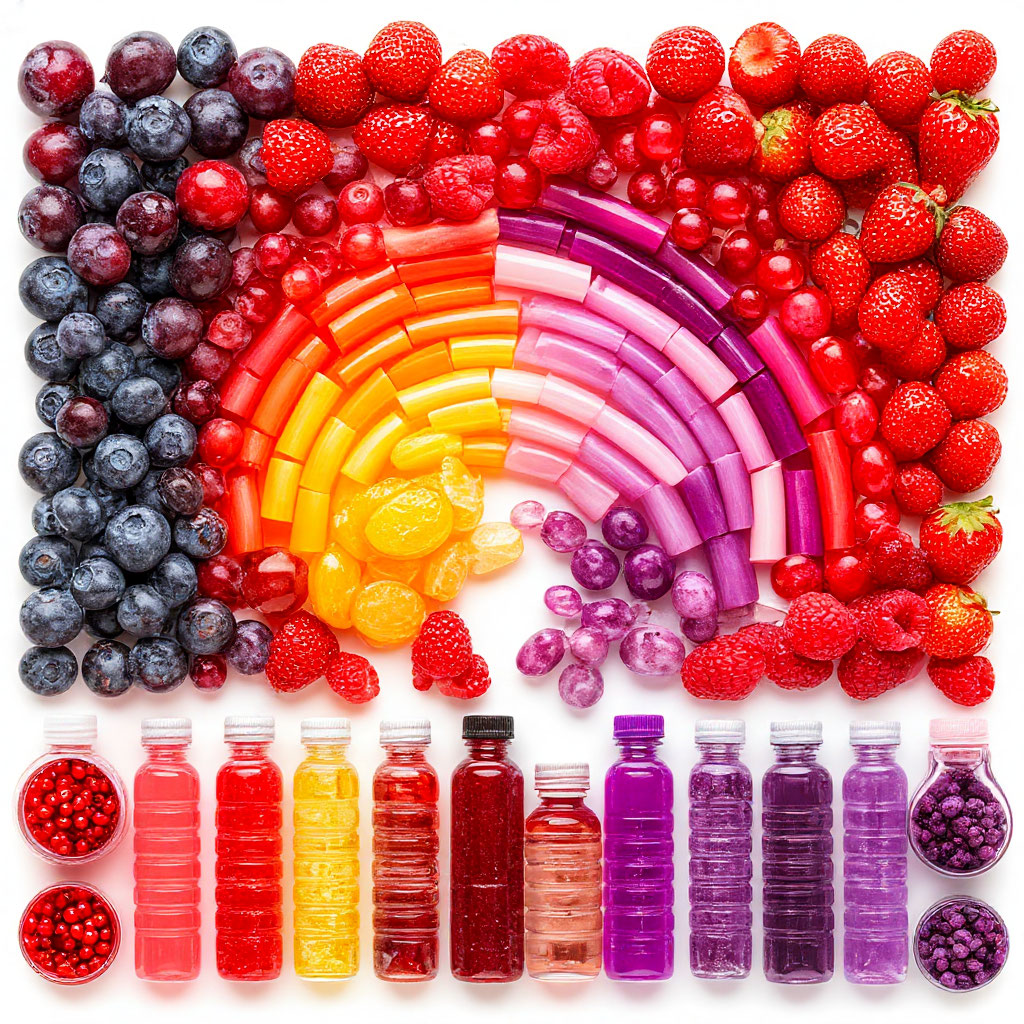
The advantage of the color diet is its naturalness. You don’t need to count calories or give up your favorite foods. Make sure that several colors are present in each meal, and the body will receive the full range of necessary substances.
This system is especially relevant in the modern world, where many people suffer from a monotonous diet and lack of vitamins. The color diet turns the process of eating into an exciting activity, where each plate is a small work of art that has health benefits.
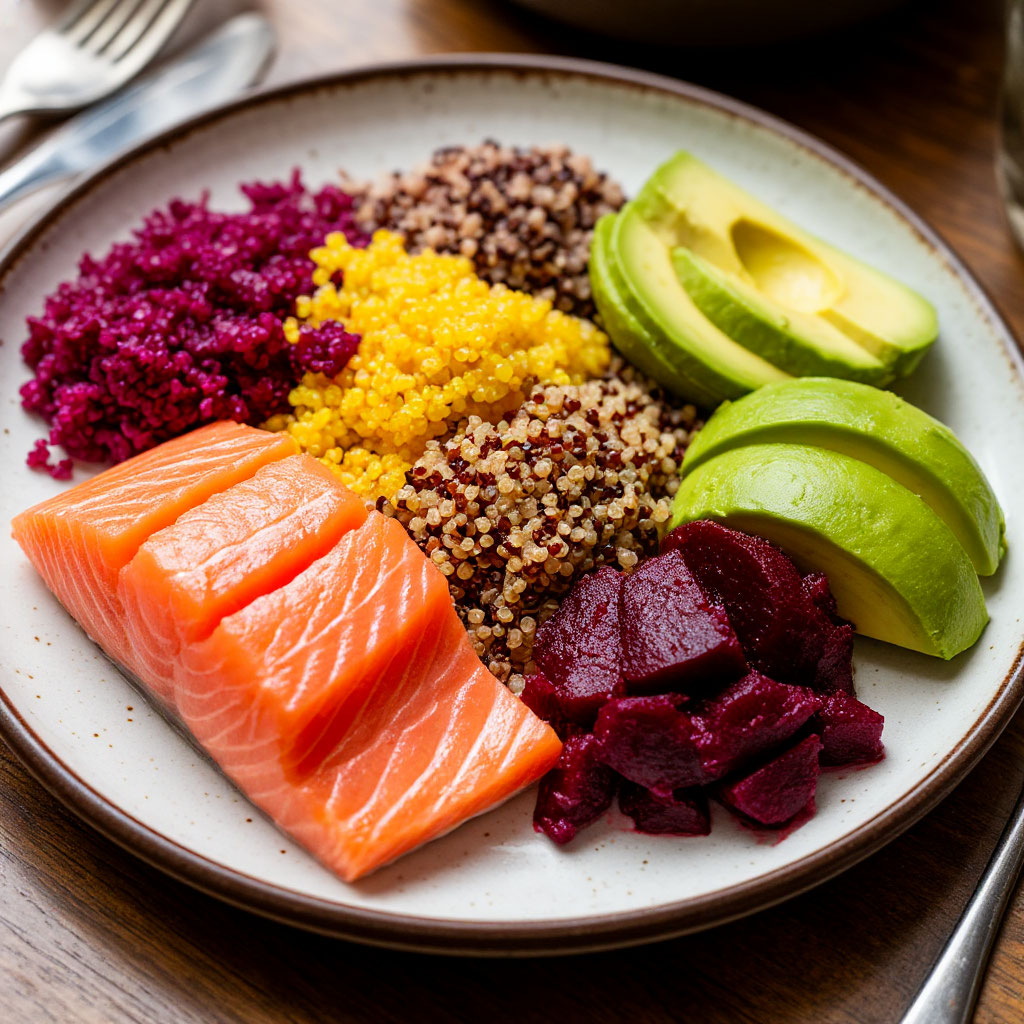
Principles of nutrition by color: how to create the perfect menu
The color diet is based on simple rules that help make the diet not only beautiful, but also as useful as possible. The main idea is that each shade on the plate brings its own benefits, and their combination creates a full-fledged nutritious cocktail.
Diversity is the foundation of success
The main principle of nutrition by color is the daily use of products from different color groups. No need to focus on one shade, because it is the combination of phytonutrients that gives the best effect. For example, breakfast might include yellow peppers and green spinach, and dinner might include purple onions and red tomatoes.
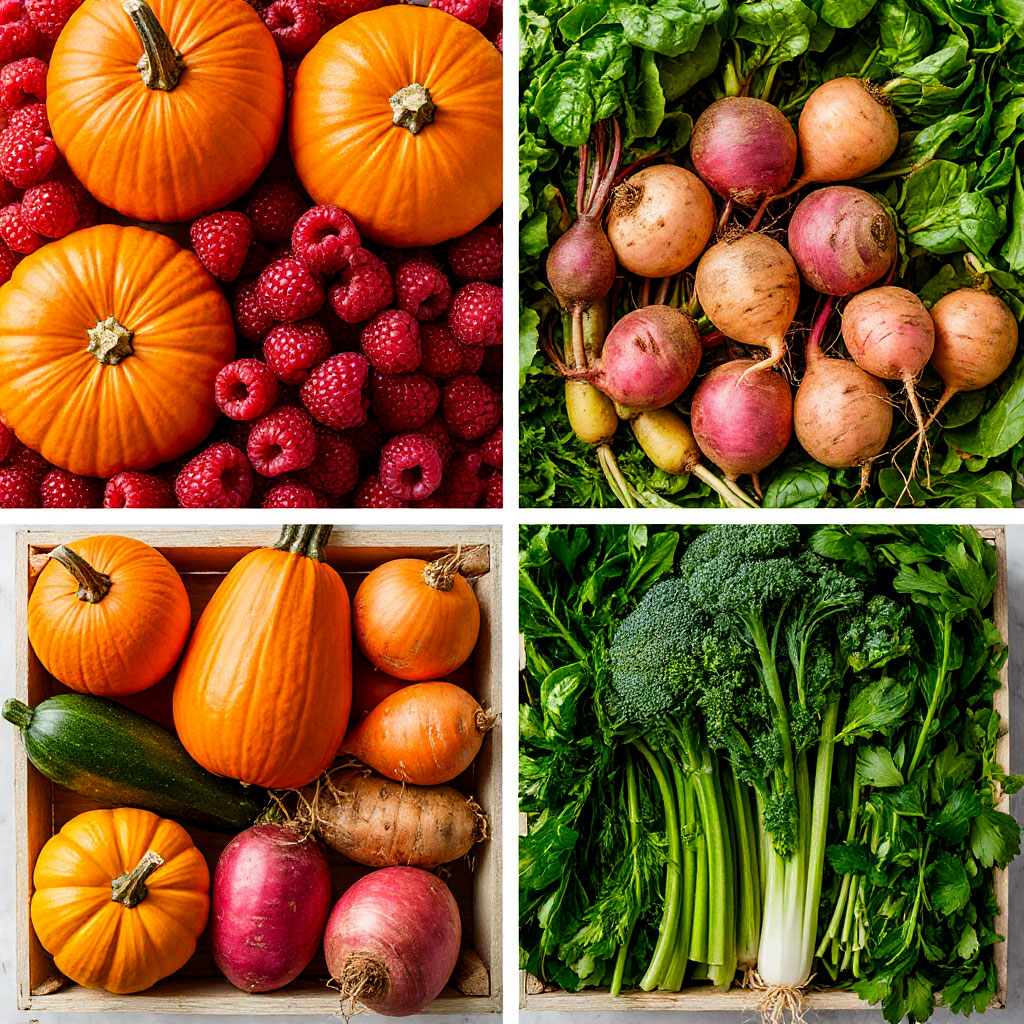
Seasonality and naturalness
The color-based diet is especially effective when using fresh, seasonal produce. In the summer, eat berries and greens, In the fall — on orange pumpkins and purple grapes. In winter, white root vegetables and frozen colorful vegetables help out.
Balance and moderation
Although color therapy in the diet does not imply strict prohibitions, it is important to observe reasonable proportions. Bright fruits contain natural sugars, so it’s best to eat them in the morning. Vegetables of all shades can be the basis for a light dinner.
The right color combination
Color diet experts recommend combining:
- Red and green foods for an antioxidant effect.
- Yellow and purple ingredients to strengthen the immune system.
- White and orange ingredients to improve digestion.

Easy cooking
A rainbow on a plate doesn’t require any culinary feats. Prepare simple dishes while maintaining the natural shades of food. Quick salads, vegetable smoothies, baked assorted dishes — all this fits perfectly into the concept of nutrition by color.
System flexibility
One of the advantages of the color diet is the ability to adapt to any preferences. Vegetarians can focus on vegetable proteins, and meat-eaters can supplement colored vegetables with low-fat protein products. The main thing is to save the palette.
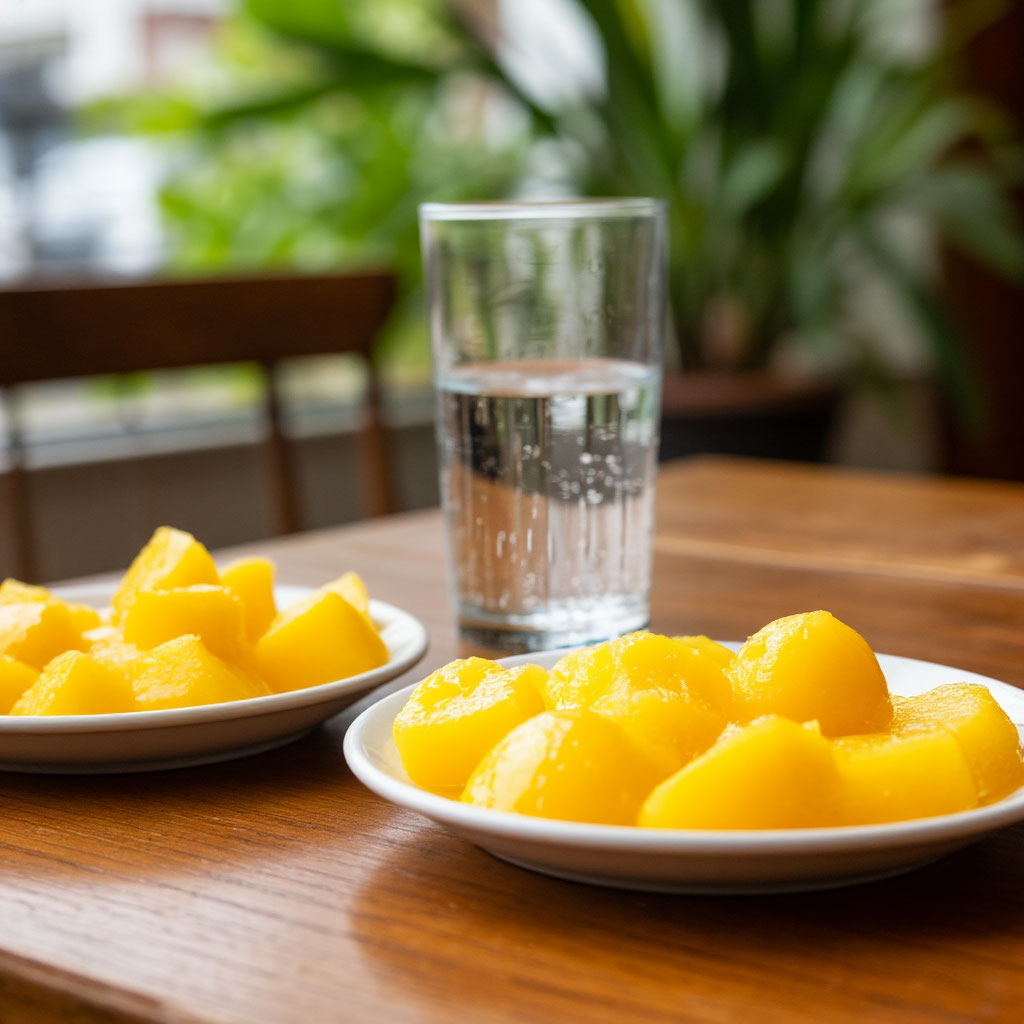
Water — an invisible participant
Do not forget about the transparent “color” – clean water. It helps absorb nutrients from colorful foods and maintains balance in the body.
The color diet is not a temporary restriction, but a lifestyle. It teaches you to consciously approach the choice of products, enjoy their appearance and get the most out of each meal.
The Benefits of Multi-colored products: Why It Works
The color diet is not just a fashion trend, but a science-based approach to nutrition. Each shade in the natural palette contains a unique set of useful substances that have a complex effect on the body.
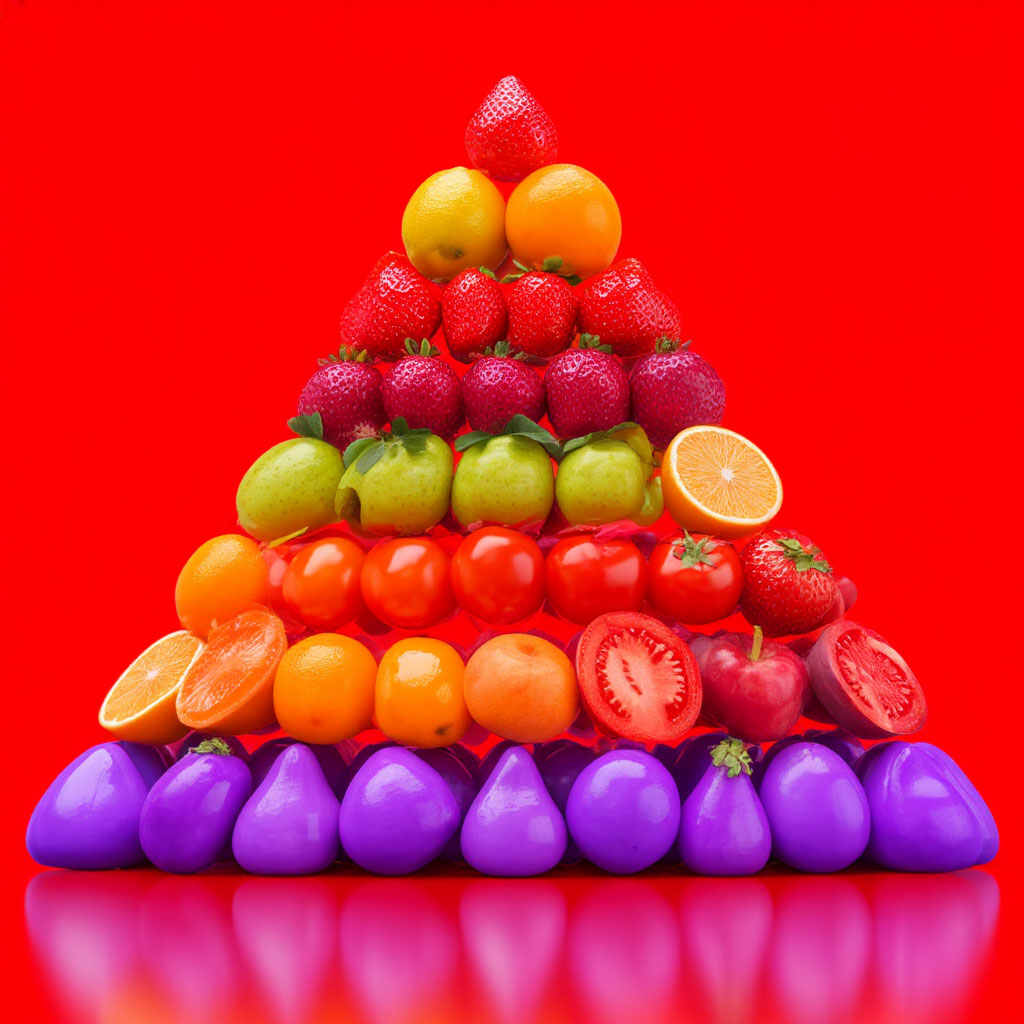
Red group: energy and protection
Products with a rich red hue are real champions in terms of antioxidant content. Lycopene in tomatoes and watermelons supports the cardiovascular system, while anthocyanins in raspberries and cherries help fight inflammation. Eating by color with an emphasis on red ingredients is useful for residents of megacities.
Orange-yellow gamma: solar charge
Bright representatives of this group — carrots, pumpkins, apricots-are rich in beta-carotene, which is converted into vitamin A. These components of the diet by color:
- support vision health;
- strengthen the immune system;
- promote skin cell renewal.
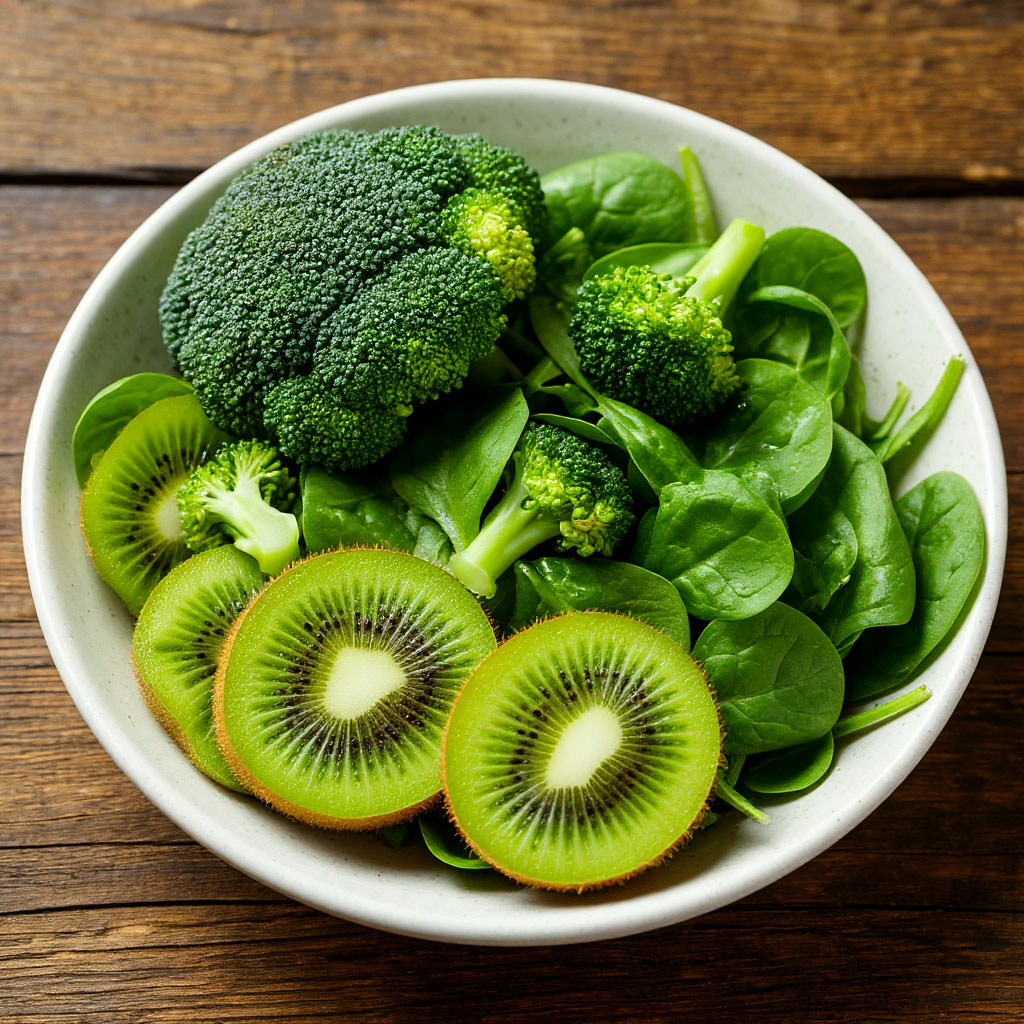
Green Diversity: a Natural Detox
Leafy vegetables and herbs contain chlorophyll — a unique substance that helps cleanse the body. Broccoli, spinach and kiwi fruit from the rainbow on a plate provide the body with vitamin K, folic acid and valuable minerals.
Blue-purple palette: prolonging youth
Dark berries and vegetables are leaders in anthocyanin content. These powerful antioxidants are part of the color diet:
- slow down the aging process;
- improve cognitive function;
- they support vascular health.
White group: natural antibiotics
Cauliflower, onion, and garlic contain allicin and quercetin, which are inconspicuous at first glance. These components of color therapy in nutrition have pronounced antiviral and anti-inflammatory properties.
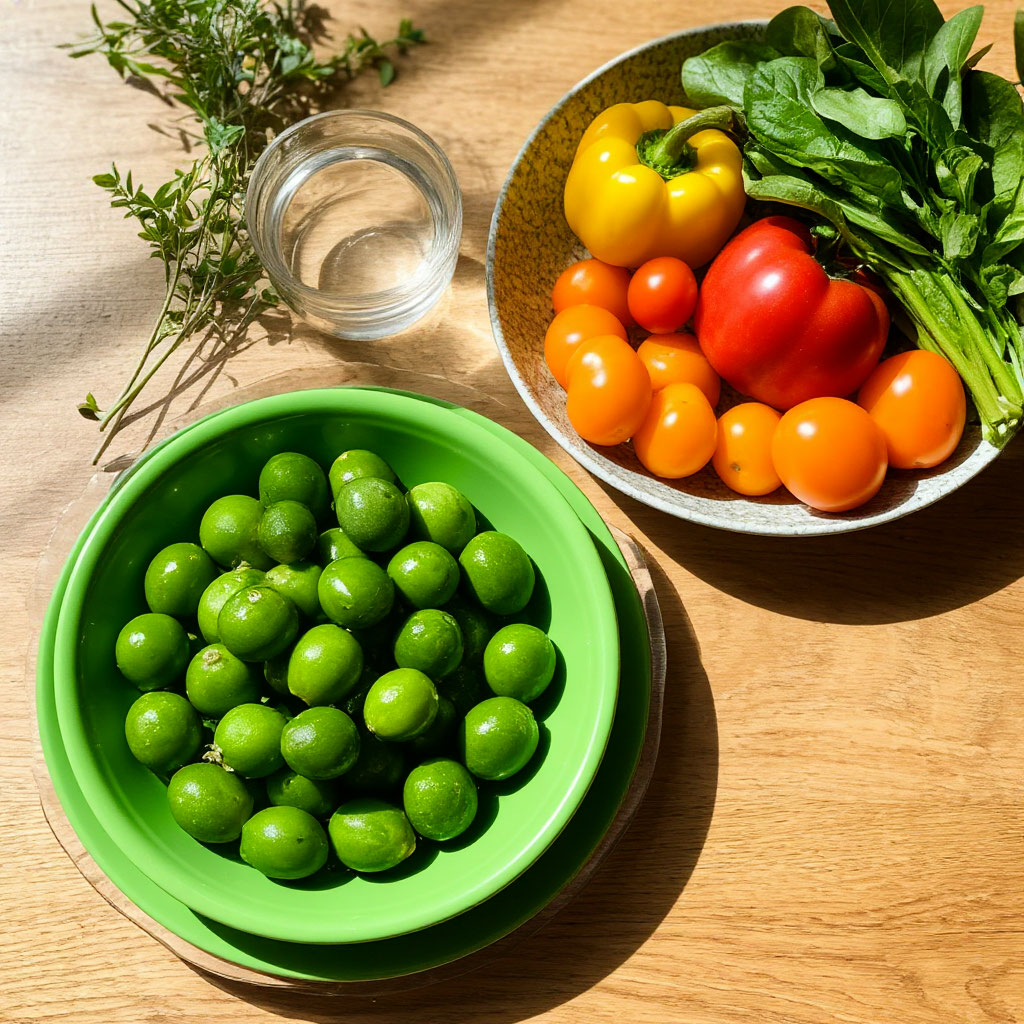
Complex effect
Combining foods of different shades in a color diet creates a synergistic effect. Vitamins and trace elements from the multi-colored menu are better absorbed, enhancing the effect of each other.
Preventive potential
Regular adherence to the principles of nutrition based on color reduces the risk of developing many diseases. Scientific studies confirm the link between eating colorful vegetables and preventing age-related changes.
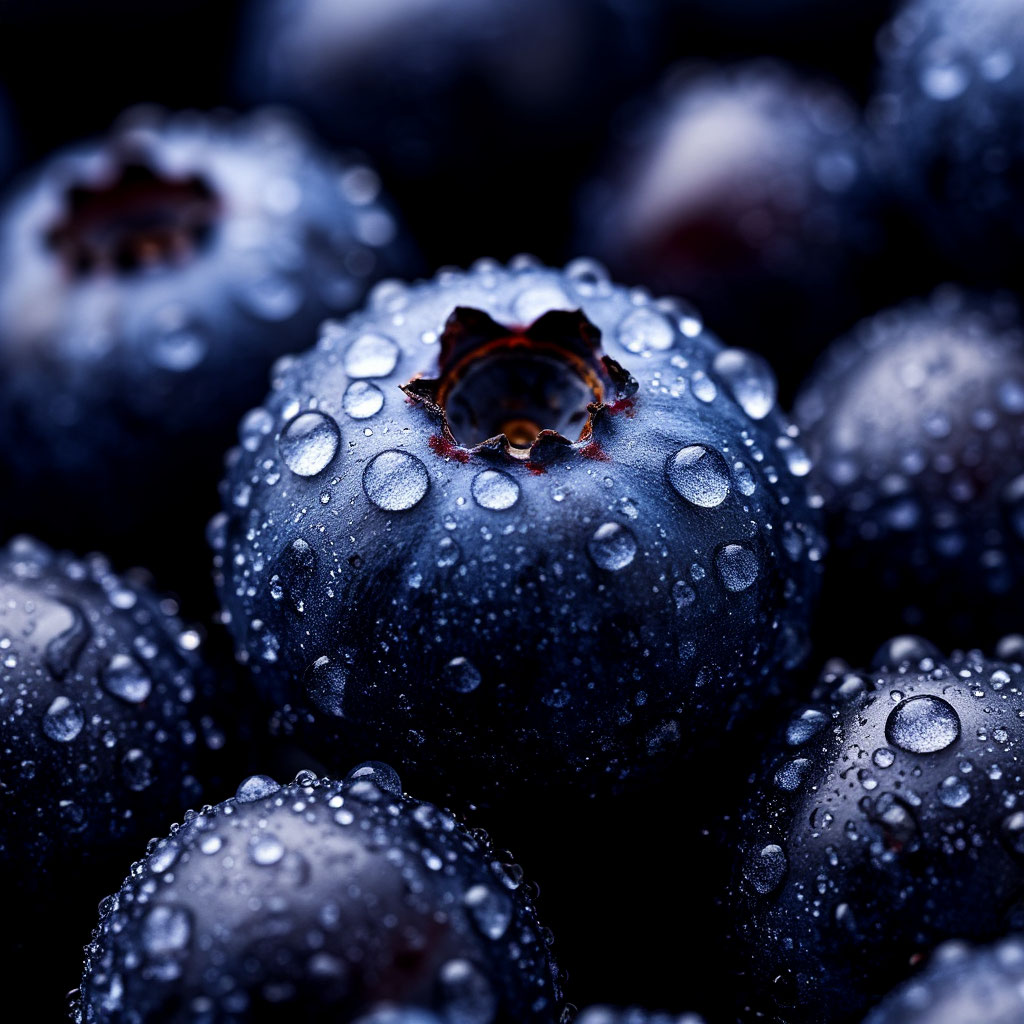
Aesthetic pleasure
The rainbow on the plate affects not only the physical, but also the psychological state. Bright, mouth-watering dishes raise your mood and promote the development of ‘joy hormones’.
The color diet offers a simple and enjoyable way to take care of your health. The variety of flavors and textures makes this style of eating not only healthy, but also fun.
Menu examples: what does the color diet look like in practice?
The color diet turns every meal into a little feast for the eyes and body. Let’s look at what a full-fledged daily menu can look like, built according to the principles of nutrition by color.
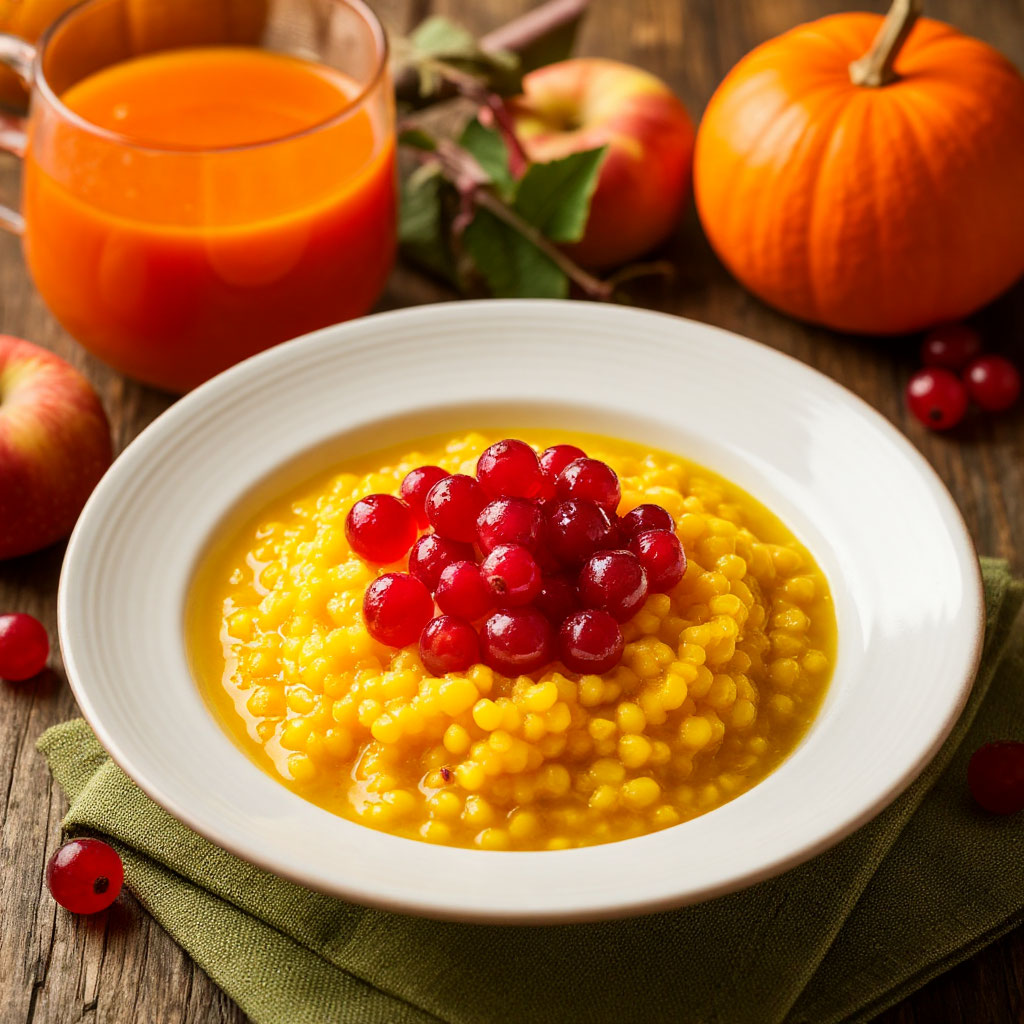
A bright start to the day
A color-based diet breakfast may include:
- Yellow corn porridge with the addition of orange pumpkin.
- Red berries as a topping.
- Green tea or fresh carrot and apple juice.
This set of products provides a boost of energy and saturates the body with vitamins in the morning.
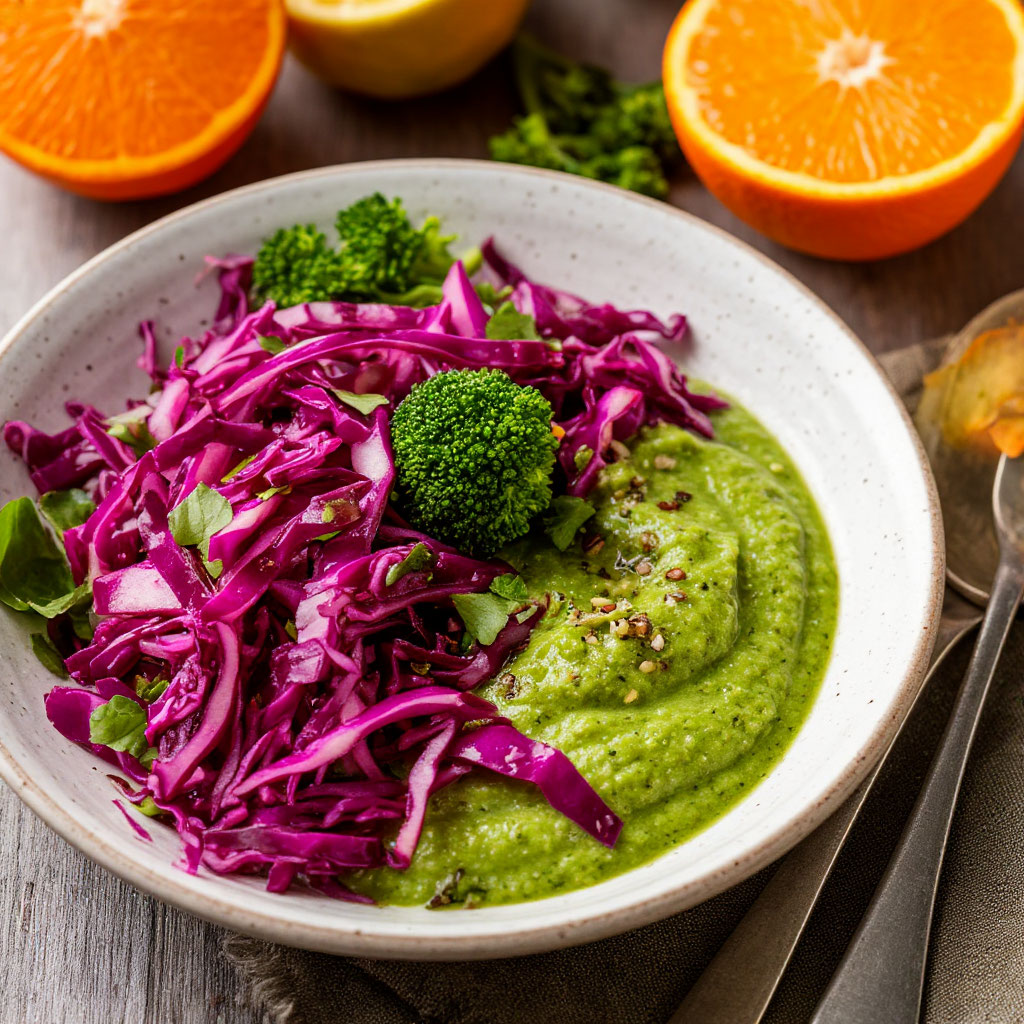
Dining rainbow
The lunch menu in the framework of color therapy in nutrition offers a rich palette of tastes. Purple cabbage and beetroot salad is combined with green broccoli puree soup. The main course can include red fish with white cauliflower, and the drink will serve as a fresh orange tangerine. This set of ingredients will provide the necessary energy for the second half of the day without feeling heavy.
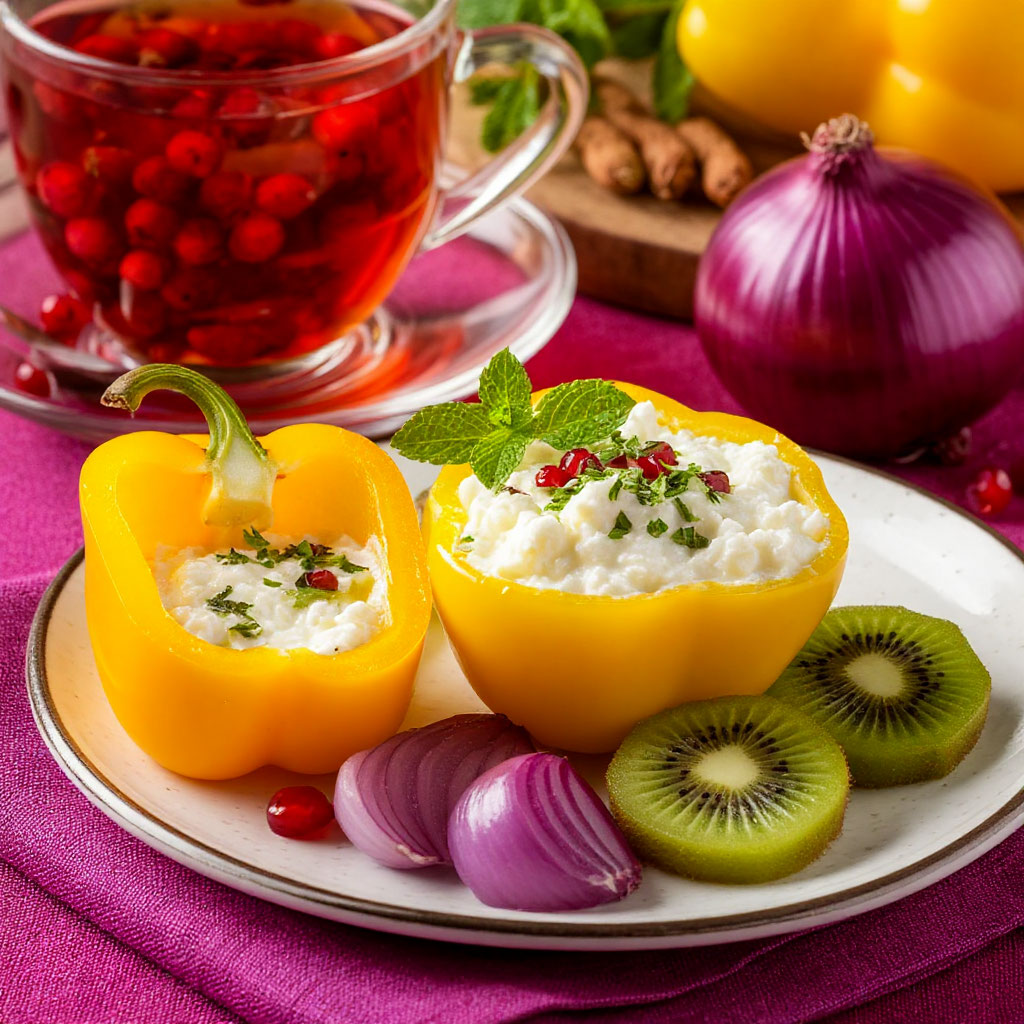
Light colored dinner
The evening meal in the color diet can consist of:
- White cottage cheese with green kiwi.
- Yellow pepper stuffed with purple onions.
- Herbal tea with red berries added.
This combination helps the body prepare for a night’s rest.
Snacks by color
Between main meals, the rainbow on the plate offers interesting combinations. Red apples perfectly harmonize with orange carrots, creating a crunchy duet. Yellow banana paired with green celery gives an unexpected flavor contrast. Purple grapes with white yogurt form a classic treat that helps maintain energy balance throughout the day.
Seasonal variations
Nutrition by color naturally changes depending on the time of year. The summer diet is saturated with fresh berries and juicy greens, in autumn orange pumpkins and purple eggplants come to the fore. In winter, the menu is based on white root vegetables and frozen vegetable mixes, and in spring, the first green vegetables and young herbs are added.
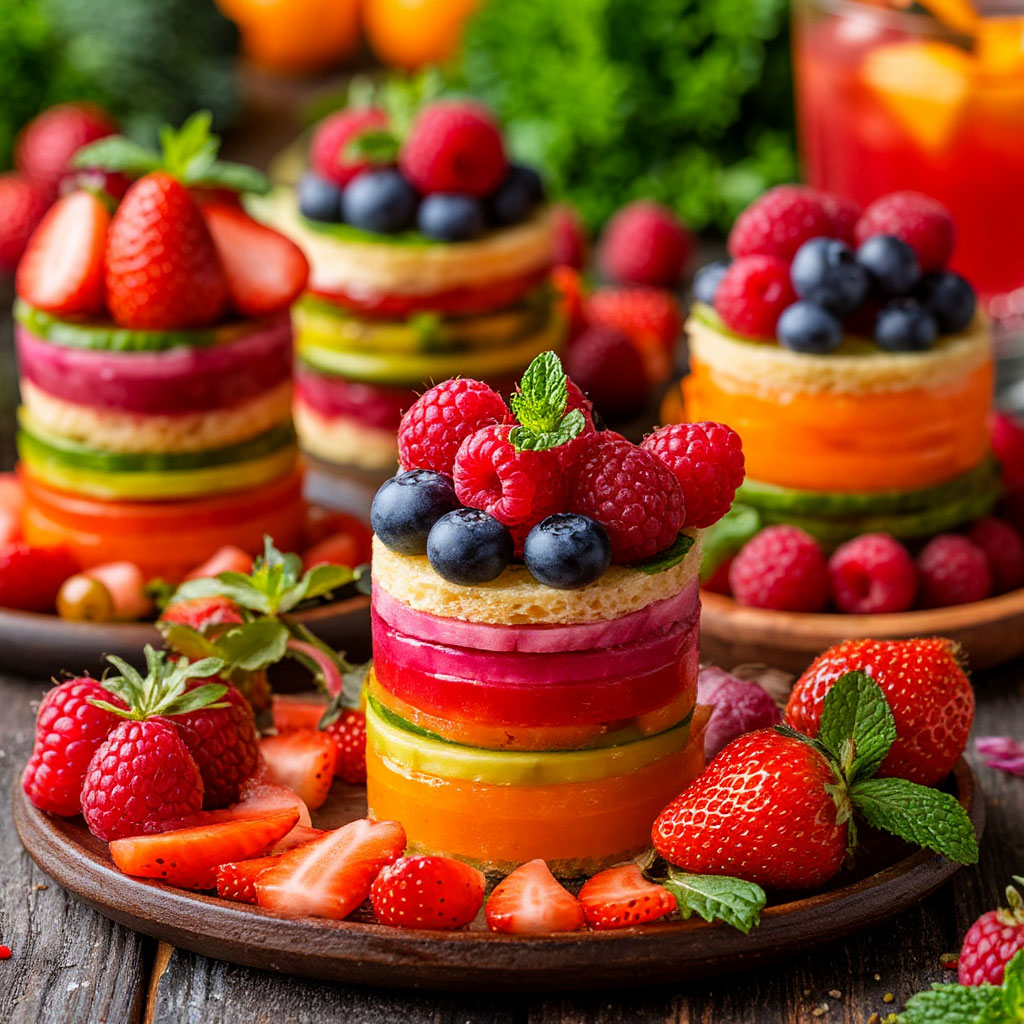
Holiday option
For special occasions, the color diet offers:
- Colorful vegetable canapes in different shades.
- Fruit plates with berries in all colors of the rainbow.
- Cocktails with layered ingredients.
Practical tips
To make the color diet as enjoyable as possible, pay attention to a few points. When buying food, choose vegetables and fruits of different shades. Culinary experiments with combinations on the plate open up new taste facets. Mastering unusual recipes with colorful products expands the gastronomic horizons. Photographing your culinary creations helps you track the variety of your diet.
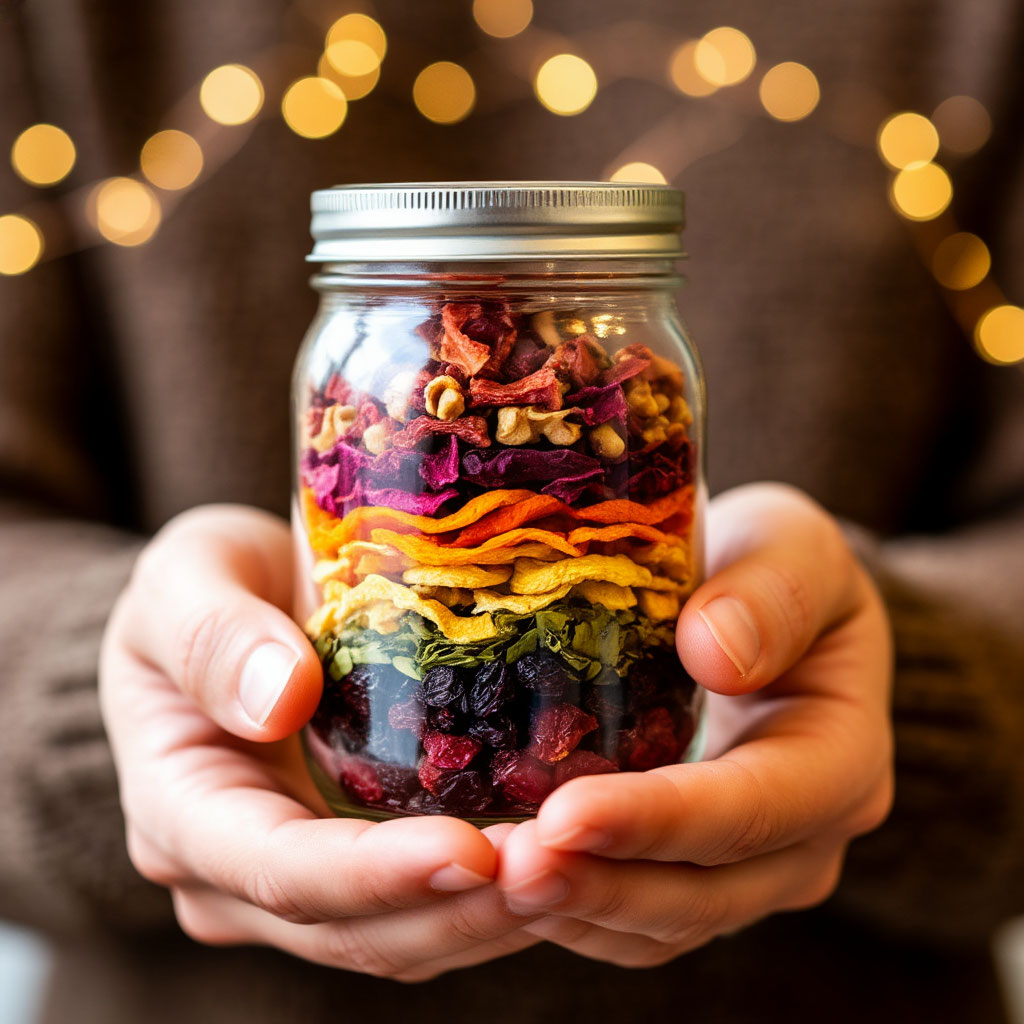
The color diet clearly demonstrates that a healthy diet can be both delicious, aesthetically appealing, and diverse. Following a simple rule – the more flowers on the plate, the more useful and interesting the diet becomes — you can completely transform your attitude to food.
Color and mood: psychology of the food palette
The color diet affects not only the physical condition, but also the emotional background. Scientific studies confirm the link between the color of food and psychological reactions. This makes color-based nutrition a powerful mood management tool.
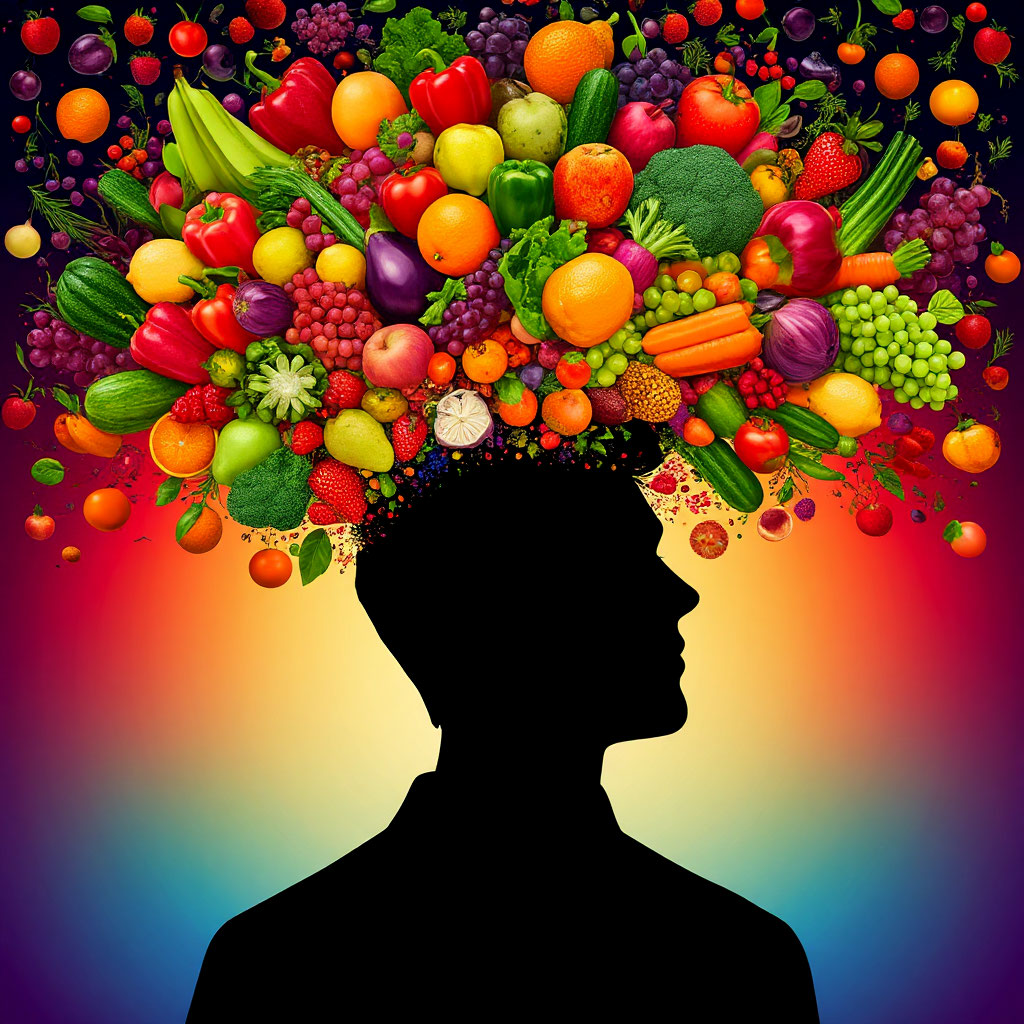
Warm tones for energy
Red and orange foods in the diet by color have a stimulating effect. Bright tomatoes, sweet peppers and citrus fruits boost energy levels and help fight apathy. These shades are associated with activity and vitality, which explains their popularity in morning meals.
Cool shades for harmony
The green and blue components of the rainbow on the plate have a calming effect. Leafy vegetables, blueberries and eggplants promote relaxation and reduce stress levels. Many nutritionists recommend including these colors in the evening diet to create an atmosphere of peace.
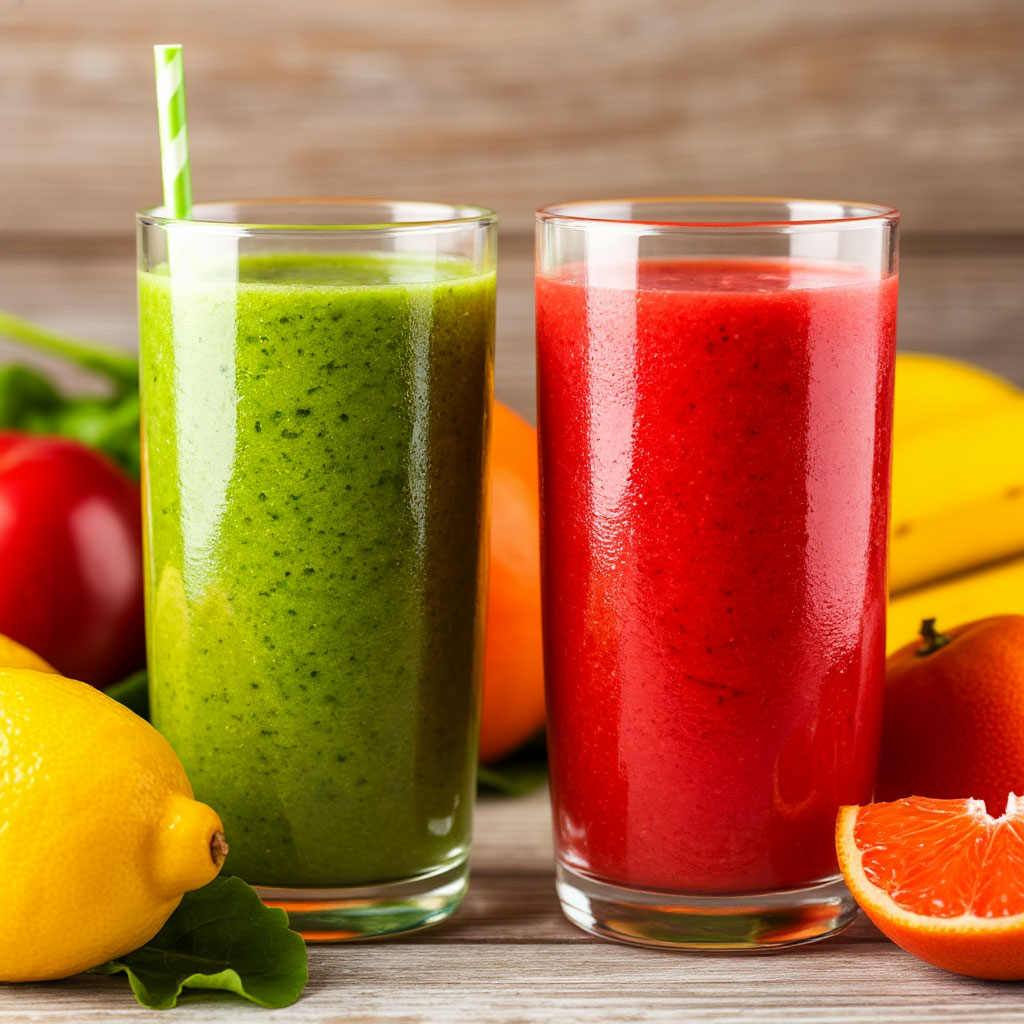
Sunny notes against the blues
Yellow products in the system of color therapy in nutrition are recognized as natural antidepressants. Bananas, corn and yellow apples stimulate the production of serotonin, improving the emotional state. Their regular use helps to maintain a positive mood on cloudy days.
Purple depth for concentration
Dark berries and vegetables in a colored diet enhance cognitive function. Blackberries, black currants, and purple carrots contain substances that improve memory and concentration. These products are useful for intense mental stress.

White purity for clarity of thought
Light foods in the diet by color create a feeling of freshness and lightness. Cauliflower, turnips, and coconut help clear your mind and help you make informed decisions. Their neutral shades balance the brightness of other colors in the diet.
Seasonal color cycles
The natural rhythms of the color diet synchronize the body’s internal clock with the external environment:
- Spring greenery awakens vitality.
- Summer bright colors are energizing.
- Autumn warm tones prepare for calm.
- Winter light shades help keep your mind clear.
Color harmony in the plate
The balanced rainbow on the plate creates a visual treat that enhances the taste experience. Aesthetically pleasing dishes increase the level of satisfaction with food, which is especially important for those who follow the diet.
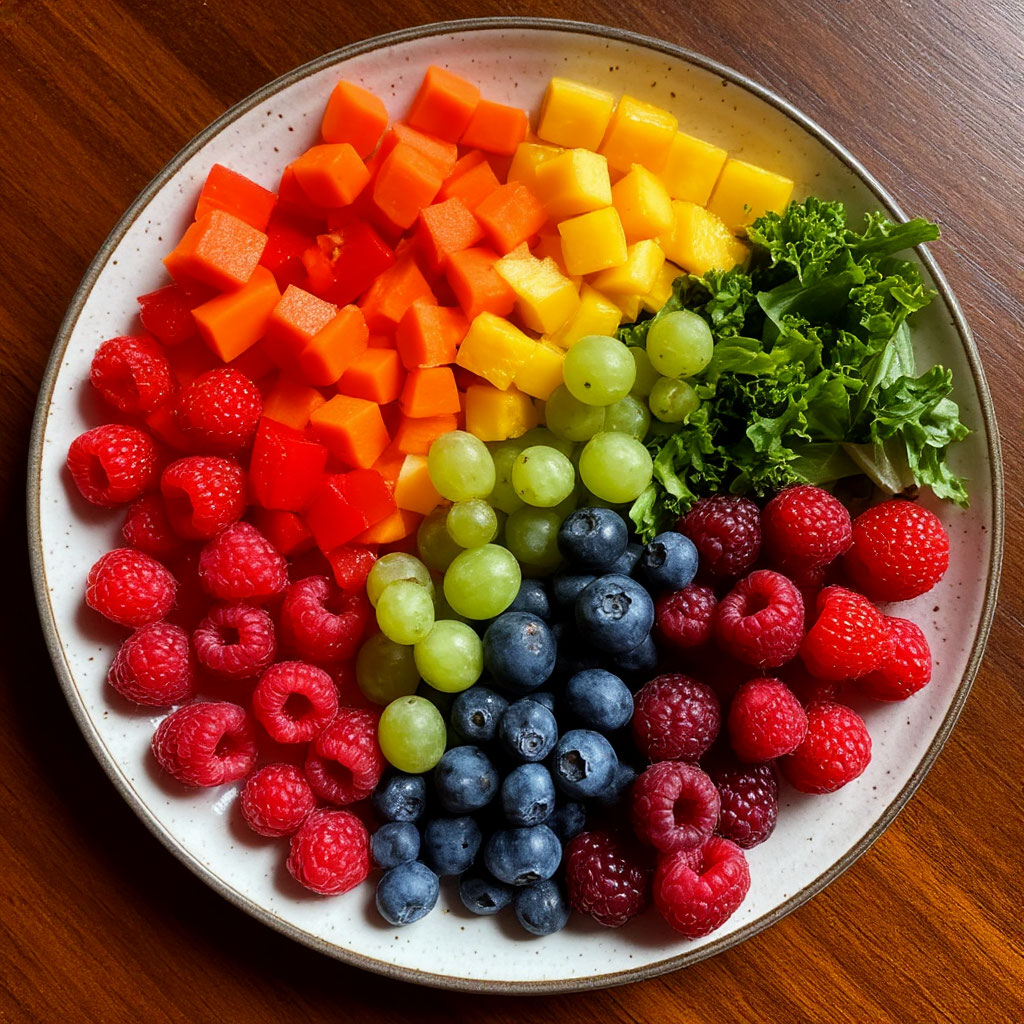
The color diet offers a unique approach to the development of not only physical, but also emotional well-being. Conscious selection of products by color scheme allows you to gently adjust the psychological state, making nutrition a mood management tool.
Who is suitable for the color diet: a personal approach to nutrition
The color diet is gaining popularity due to the versatility and flexibility of the system. This style of eating resonates with many people, each of whom discovers the unique benefits of nutrition by color.
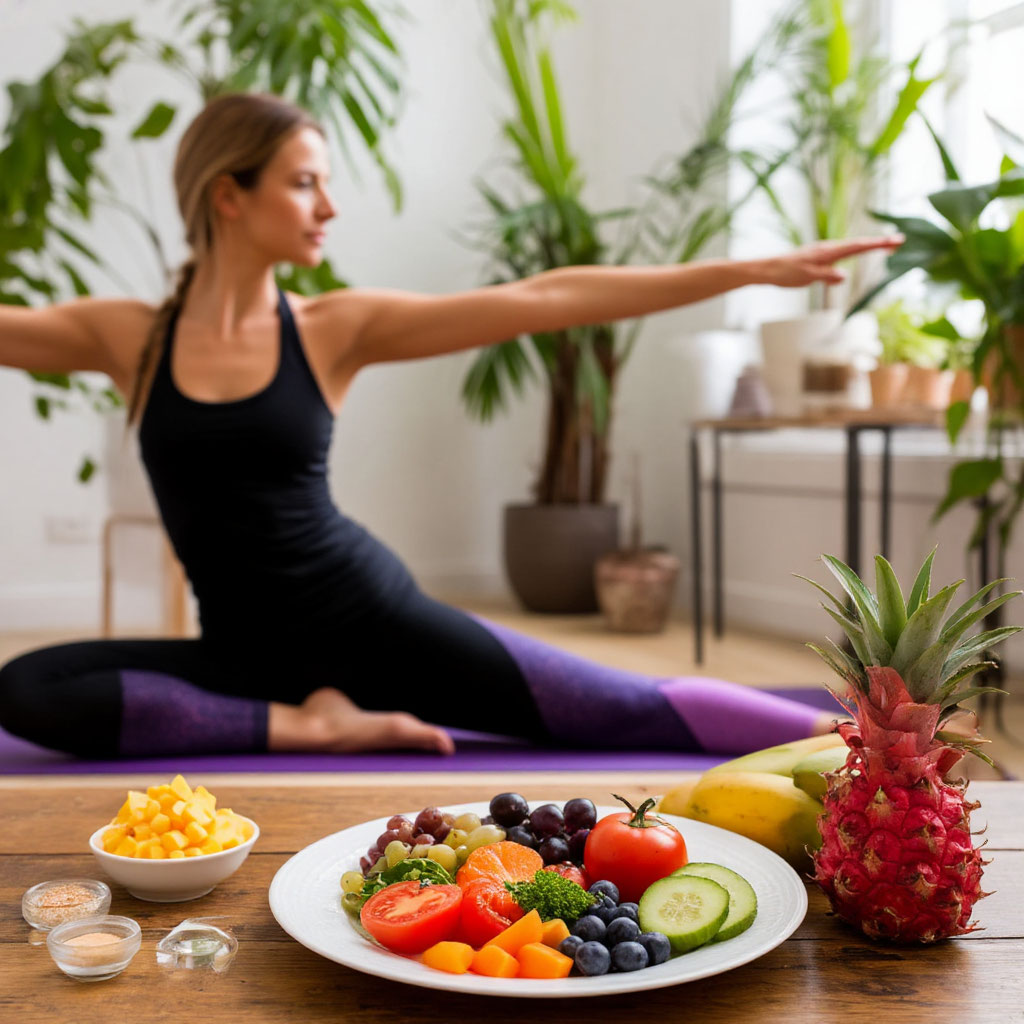
For supporters of a healthy lifestyle
Adherents of healthy lifestyle evaluate the diet by color for a natural approach to the composition of the diet. The system helps to avoid micronutrient deficiencies, as multi-colored products contain a full range of essential substances. Regular consumption of vegetables and fruits of different shades strengthens the immune system and increases vitality.
For busy people
Rainbow on a plate is perfect for those who appreciate simplicity and practicality. The method does not require complex calorie calculations or portion weighting. It is enough to monitor the color diversity in each meal, which easily fits into the busy schedule of a modern person.
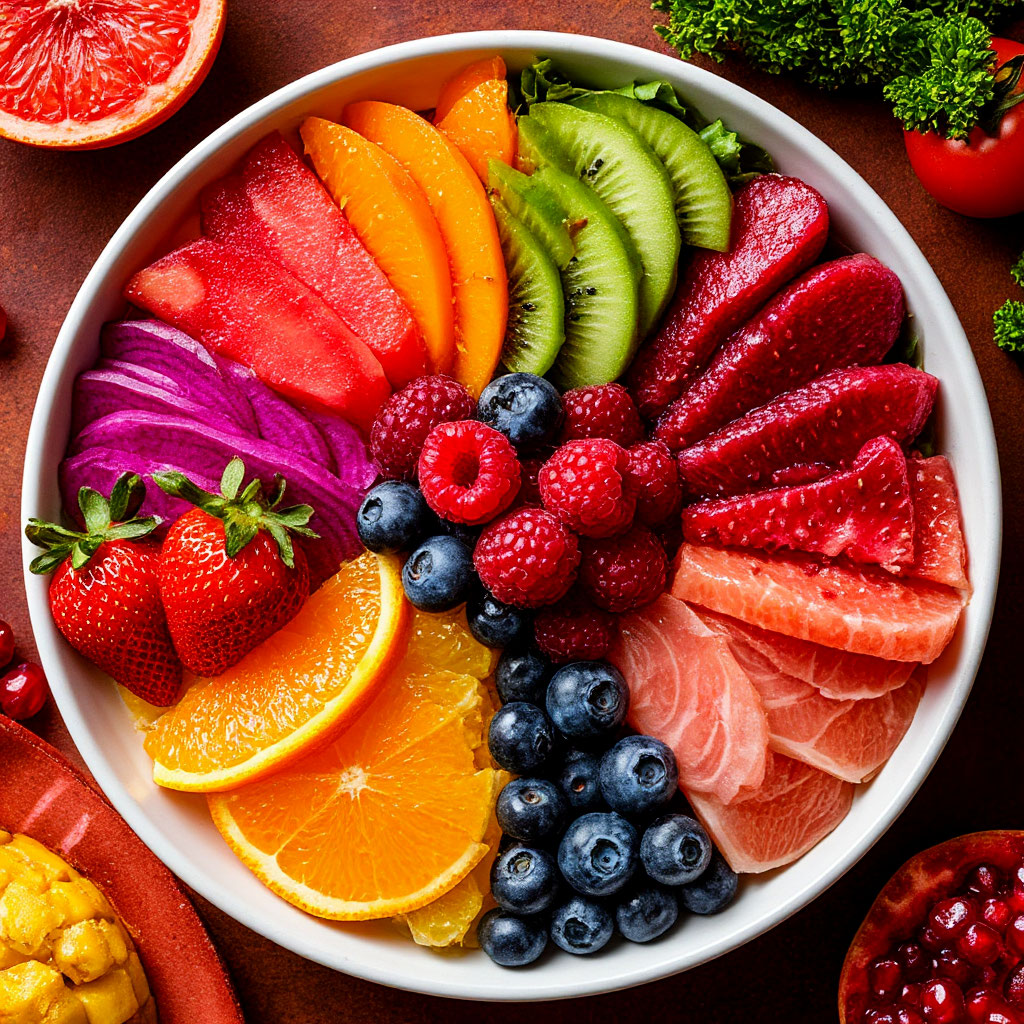
For creative people
People with an artistic taste find color therapy in nutrition a source of inspiration. Making beautiful compositions of colorful products turns an ordinary meal into a creative process. Photogenic dishes become a source of pride and decoration of social feeds.
For families with children
The color diet is especially popular with children who enjoy trying “fun” food. Bright fruit cuts and assorted vegetables in a playful way teach you to eat healthy. Parents note that kids are more willing to eat vegetables when they are presented in a multi-colored version.

For age groups
People of mature age appreciate nutrition by color for its preventive effect. Regular consumption of antioxidants from colorful vegetables and fruits helps maintain mental clarity and physical activity. The simplicity of the system makes it accessible to all ages.
For athletes
Professional athletes and fitness enthusiasts incorporate the principles of the color-based diet into their nutrition programs. Colorful vegetables provide the body with essential vitamins, and fruits provide natural sugars to restore energy after exercise.
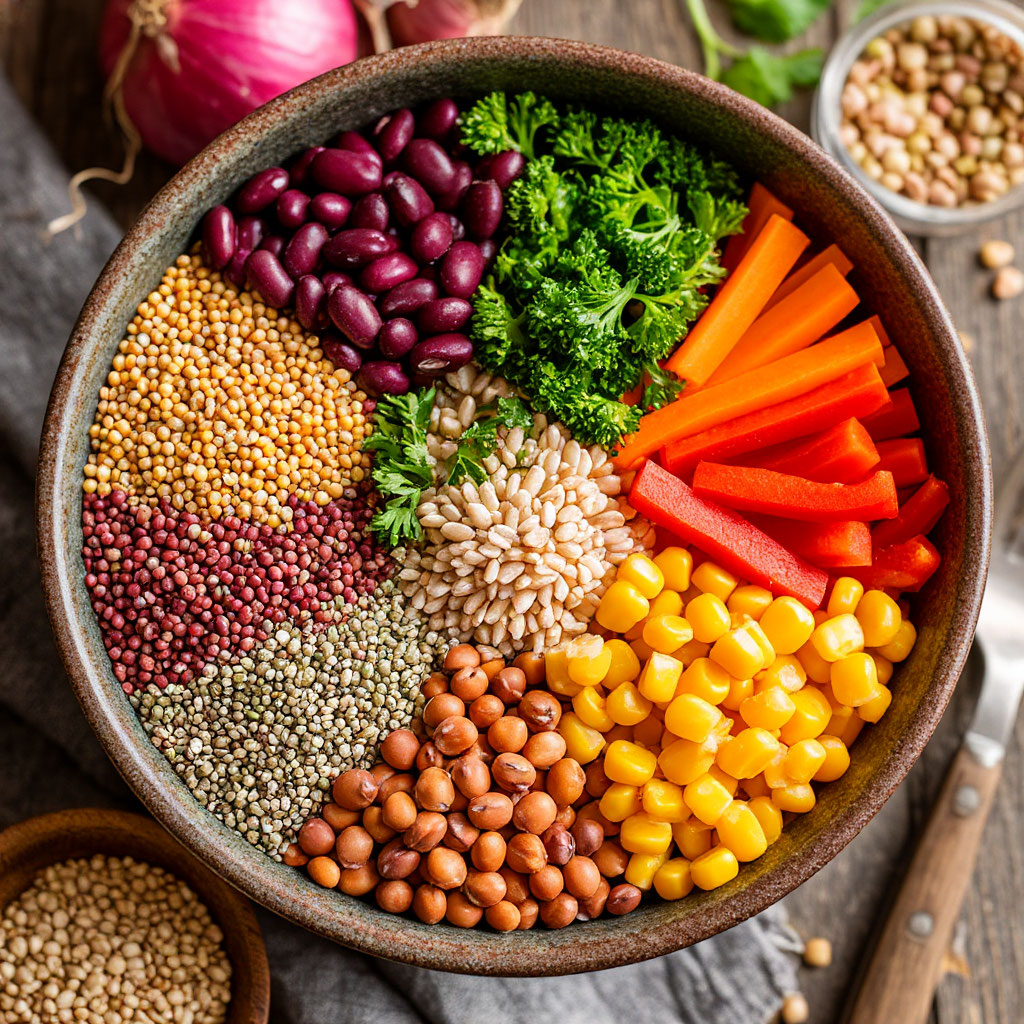
For vegetarians
Plant-based dieters find the rainbow on their plate the perfect way to balance their diets. By combining legumes, cereals, and vegetables of different colors, you can get a complete set of amino acids without using animal products.
Contraindications and restrictions
Despite the universality of the color diet, there are individual characteristics. People who are allergic to certain pigments should exclude the relevant products. In case of chronic diseases, it is recommended to consult with a nutritionist to adapt the system.
The color diet shows amazing flexibility, adapting to different needs and lifestyles. The lack of rigid frameworks makes this approach to nutrition comfortable and sustainable in the long run.
The color diet reveals a new approach to a healthy lifestyle, turning every meal into a conscious ritual. This system proves that proper nutrition can be bright, tasty and varied. Nutrition by color does not limit, but expands the gastronomic horizons, offering a natural path to a balance of vitamins and trace elements.
By following the principles of the color diet, you can not only improve your physical condition, but also get aesthetic pleasure from the rainbow on your plate. Color therapy in nutrition becomes a simple and pleasant way to take care of yourself, accessible to everyone who values health and beauty in everyday life.



